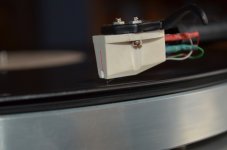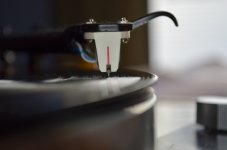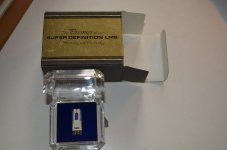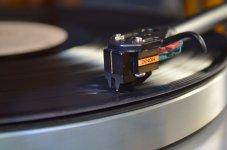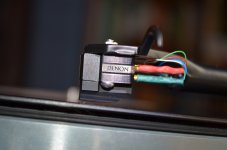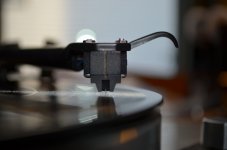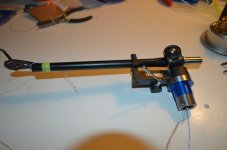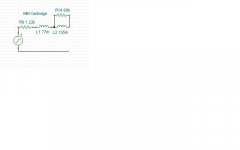Better be aluminum ones.I'm just realizing I need longer mounting screws. I'll pick some up tomorrow.
or non-magnetic stainless steel.
Do magnetic material bolts actually make a difference?
AIUI, (magnetic) steel bolts are not a good idea; (non-magnetic) aluminium, brass or ss are preferable.
But whether you can hear a sonic difference between these 3 latter metals is a matter of conjecture. I would suggest that which one you choose is more related to how much you want the combined (cartridge weight + screw weight) to be ... so that it optimises the cart/arm resonance. 😕
Regards,
Andy
Last edited:
Very clear pictures. Aesthetically better than the 301 II and in excellent condition. Congratulations.
Yes, good luck nezbleu! I hope it sounds well.
Regards
or non-magnetic stainless steel.
Do magnetic material bolts actually make a difference?
I would near magnetic ones to the cart's body by hand before mounting. If they would feel like pulling when at actual mounting distance from the cart's magnet they should affect the magnetic field a little. The 103R and the AT had non magnetic screws in their boxes for example. The other thing is the added mass. How much and in what way its heading the subsonic resonance. Brass long screws and nuts can be adding quite much for instance. Or steel vs. Aluminium.
Looks are much more complimentary to the arm than with the previous. What about sonics? Any better?
I need to listen more, but so far very nice. Crystal clear highs with sparkle, maybe a little hot. Lows seem lighter but more controlled. I might need to add a little capacitance at C2Y. I wonder if I need to adjust loading. Either way, initial impressions are very positive.
Maybe some tail down VTA would fix it? But the Rega is a pain for that...or you got some height adjusting accessory installed?
Seems like a good initial result nonetheless. Yes, balance the tone by electrical means if fine mechanical is not flexible. What is the DL-311LC's subsonic resonance with the Rega?
P.S. Try 200R load at a point also.
Seems like a good initial result nonetheless. Yes, balance the tone by electrical means if fine mechanical is not flexible. What is the DL-311LC's subsonic resonance with the Rega?
P.S. Try 200R load at a point also.
Per the vinylengine.com figures and their resonance calculator tool, it should be about 10-11 Hz (depending on mass of mounting hardware, but I used aluminum bolts so that shouldn't be very high). It might be a bit lower, because I understand that Denon spec cartridge compliance at 100Hz and it might be higher at lower frequencies. Data sheet says 12e-6 cm/Dyne.
I have a height adjuster installed (see photo), but it is already as low as it will go. I would need to modify the arm board to get it lower -- which I have considered doing. However, there is not a lot to "fix", just a bit of "tilt" to the frequency response (by my ears). Sometimes reducing a hot treble makes the bass sound "fuller" at the same apparent volume. So I'll listen for a while, and if I still think it's a bit hot after more records, I'll up C2Y to 200pF.
I have a height adjuster installed (see photo), but it is already as low as it will go. I would need to modify the arm board to get it lower -- which I have considered doing. However, there is not a lot to "fix", just a bit of "tilt" to the frequency response (by my ears). Sometimes reducing a hot treble makes the bass sound "fuller" at the same apparent volume. So I'll listen for a while, and if I still think it's a bit hot after more records, I'll up C2Y to 200pF.
Attachments
It should be 18-24cu. When you see 100Hz spec its X1.5-2 for 10Hz. Given the mechanical situation you describe and the slight only tonal aberration, C2Y trim sounds like the best/easiest place to play indeed.
Another thing influential regarding treble tone beyond the usual arm & cart geometry stuff is absolute platter speed. Using a test record with a sinewave tone, usually 300Hz or 1kHz, hook up the DMM in AC mode + Hz mode on the FSP's output, or the line preamp's output. See if the TT is slow or fast and trim it for showing the exact test tone frequency.
I was very keen to try this after reading it, Salas (as the TT PSU I am using allows me to program the output AC Hz to 0.001Hz - so just tried it now: ... 🙁 🙁
* I have DMM which has a 'Hz mode',
* so I selected this and put it to AC,
* played a 1KHz tone,
* plugged a 'bare' RCA plug into the secondary L output of my phono stage (while listening to the 1KHz tone through the speakers), and
* attached the DMM leads to this bare RCA plug.
The meter read 0.004KHz ... so 4Hz? Is it just that my DMM is wrongly calibrated (for Hz)?
Regards,
Andy
What is your DMM's brand and model number?
TENMA 72-4025, Salas.
Andy
It could just be insensitive especially at 1kHz, some need stronger signal or their frequency counter sensitivity is targeted in the band up to 500Hz. Turn the system up a bit and try it across the speaker terminals.
It could just be insensitive especially at 1kHz, some need stronger signal or their frequency counter sensitivity is targeted in the band up to 500Hz. Turn the system up a bit and try it across the speaker terminals.
I'll try the speaker terminals, Salas.
Thanks,
Andy
Yes, it worked, Salas! 😀 (But I had to turn up the volume quite a bit!! 😉 )
At 33 1/3rpm, the meter read just under 1KHz - so I will have to increase the Hz delivered by the TT PSU. Which is no problem, as I can program it to 0.001Hz.
Playing a 33 1/3rd RPM Test Disc at 45rpm delivers 1,350Hz (for a 1KHz tone) ... my meter read 1,360Hz - so I need to slightly decrease the frequency which had been set for 45rpm.
The above is tomorrow evening's job, after work. 🙂
Thank you for your suggestions, Salas. 😀
Andy
At 33 1/3rpm, the meter read just under 1KHz - so I will have to increase the Hz delivered by the TT PSU. Which is no problem, as I can program it to 0.001Hz.
Playing a 33 1/3rd RPM Test Disc at 45rpm delivers 1,350Hz (for a 1KHz tone) ... my meter read 1,360Hz - so I need to slightly decrease the frequency which had been set for 45rpm.
The above is tomorrow evening's job, after work. 🙂
Thank you for your suggestions, Salas. 😀
Andy
Nice. BTW, grab a UNI-T U61E somewhere online on first chance. Easier to use than your Tenma bcs its auto ranging and It has a sensitive 0.1% spec frequency counter that extends far high, plus its true RMS and 22000 counts. Can datalog on a PC also. Keep the Tenma as secondary meter and Hfe tool.
- Home
- Source & Line
- Analogue Source
- Simplistic NJFET RIAA
